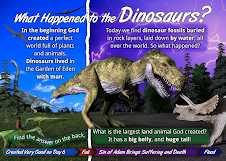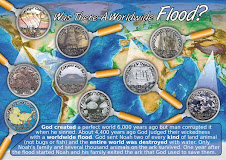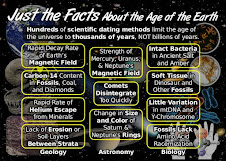By Joseph Simon
1.
Johann Kepler (1571-1630): Discovered laws of
planetary motion. Determined sun was
center of solar system, not the earth.
He was an earnest Christian who stated that he was simply thinking God’s
thoughts after him. Believed in a young
earth.
2.
Sir Isaac Newton (1643-1727): Discovered universal law of gravitation,
developed calculus. Came up with the 3
laws governing motion, the law of inertia which states a body in motion will
stay in motion unless acted upon by another force and a body at rest will stay
that way unless acted upon by a force, F=ma and for every action there is an
equal and opposite reaction. He did work
with optics, showing a prism could separate light into primary colors. He invented the reflecting telescope. Developed the universal law of gravitation,
F=g*m1*m2/r^2. In a 2005 poll of the Royal Society of
London for the Improvement of Natural Knowledge, founded in 1660, Newton was voted the most influential
scientist of all time, even more so than Einstein. He wrote more on religion than natural
science. Newton saw God as the master creator whose
existence could not be denied in the face of the grandeur of all creation. He believed in Christ as his Savior and defended
Sir William Ussher’s biblical chronology dating the earth at 5700 years in his
day.
3.
James Joule (1818-1889): Studied the nature of heat
and established its relationship to mechanical work. This led to the discovery of the first law of
thermodynamics: The increase in the internal energy of a thermodynamic
system is equal to the amount of heat energy added to the system minus the work
done by the system on the surroundings.
He was a man of sincere Christian faith.
4.
James Simpson (1811-1870): This man read Genesis 2:21 which states that God
caused a deep sleep to fall upon Adam, and he slept, and He took one of his
ribs, and closed up the flesh instead thereof and made woman and brought her to
the man. He surmised that this deep sleep
goes beyond normal sleep, and that a substance must exist to cause this to
happen. He discovered the effects of
chloroform as an anesthetic and laid the foundation of modern
anesthesiology. He stated that his
greatest discovery was that he had a Savior.
He wrote a Gospel tract which concludes with “But again I looked and saw
Jesus, my substitute, scourged in my stead and dying on the cross for me. I looked and cried and was forgiven. And it seems to be my duty to tell you of
that savior, to see if you will not also look and live. He was wounded for our transgressions (Isaiah
53:5,6).
5.
Joseph Lister (1827-1912): He was an English surgeon whose great
contribution was the development of antiseptic surgery through the use of
chemical disinfectants including carbonic acid.
He founded the Lister Institute of Preventive Medicine in London. His work has saved untold millions. Listerine mouthwash is named after him. He was of a Quaker background and wrote “I am
a firm believer in the fundamental doctrines of Christianity”.
6.
Louis Pasteur (1822-1895): One of the greatest
names in the history of science and medicine mainly because of his
establishment of the germ theory of disease and his conclusive demolition of
the the-prevalent pre-evolutionary concept of spontaneous generation which
stated that organisms basically spontaneously generate based on maggots
appearing in meat. He came up with
vaccines to combat rabies, diphtheria, anthrax and others. Obviously he developed the process of
pasteurization and sterilization (anyone had milk today). He undoubtedly made the greatest contribution
of any one man in saving lives and many consider him the greatest biologist of
all time (even though Darwin is far more popular and contributed to far more
deaths than any one man). God says in
His word, “whoever hates me loves death”.
Unfortunately he was the object of intense opposition by the biological
establishment due to his own opposition to spontaneous generation and
Darwinism. He was a strongly religious
man who’s faith grew stronger as he grew older.
7.
Samuel Morse (1791-1872): Famous for inventing the telegraph, one of
the most important milestones in human history.
This totally revolutionized humanity creating instant communications. What is the first message transmitted over
electronic media? A message by Morse
asking “What has God wrought” (Numbers 23:23). Four years before he died he said “The nearer
I approach the end of my pilgrimage, the clearer is the evidence of the divine
origin of the Bible, the grandeur and sublimity of God’s remedy for fallen man
are more appreciated, and the future is illuminated with hope and joy.
8.
Michael Faraday (1791-1867): Discovered the principle of electromagnetic
induction which is the process by which current is induced in a wire by a
moving magnetic field. Using this
principle he invented the generator. His
inventions of electromagnetic rotary devices led to the development of electric
motors. It was largely due to his
efforts that electricity became viable for use in technology. He was also a chemist who discovered
benzene. He is considered one of the
most influential scientists in history.
This man was a humble and sincere Christian. He was a member of the Sandemanian sect, a
small church whose teaching included emphasis on God’s creation as purposeful
and harmonious, designed for man’s well being.
He believed the Bible and science were in complete agreement. His church’s statement of fiath included a
line stating that faith in the divinity and work of Christ is the gift of God,
and the evidence of this faith is obedience to the command of Christ.
9.
James Clerk Maxwell
(1831-1879): Building on the concepts of
his friend Michael Faraday, he developed a comprehensive theoretical and
mathematical framework of the electromagnetic field theory. He came up with the four Maxwell equations
which describe the relationship between electric and magnetic fields and their
interactions with matter. He was also
involved with photography, discovering that color photographs could be formed
using red, green and blue filters. Much
is owed to him for the eventual transmission of electromagnetic waves
(telecommunications).
About Maxwell, Albert Einstein said “The work
of Maxwell] ... the most profound and the most fruitful that physics has experienced
since the time of Newton”. He was fundamentalist in his Christian
beliefs, and was strongly opposed to evolution.
He wrote a refutation of Darwinism.
He said his motivation for his work was the Genesis account of man
having been created in His image and the command to subdue the earth. He acknowledged his personal faith in Jesus
Christ.
10.
Matthew
Fontaine Maury (1806-1873): Matthew Maury joined the U.S. Navy and
sailed all over the world. He remembered a verse his father had read from the
Bible about “paths” in the sea – Psalm 8:6-8 “…and whatsoever passes through
the paths of the sea…”. If the Bible said there were paths in the sea, Matthew
was sure that the sailors could find them. Maury injured his leg in an
accident, but stayed in the navy. With the help of other sailors he was able to
find and map on of these “paths”. Ships following this path (current) shortened
a 70 day trip to 24 days. Soon ship captains from many countries were sending
Maury the information he needed to map his “paths”. The currents Maury mapped
made ocean travel quicker, smoother and safer. Even today ships use the maps
made by Lt. Matthew Maury, “the pathfinder of the seas”. His book is called Wind and Current Charts. This is from a
speech he gave in Tennessee in 1860: “The
Bible is authority for everything it touches… When you men of science, with
vain and hasty conceit, announce the discovery of disagreement between [the
Bible and science], rely upon it, the fault is not with the witness of His
records, but with the worm who essays to interpret evidence which he does not
understand.”
Now ask yourself this, What did Charles Darwin accomplish?
I believe evolutionary ideas actually hinder scientific research. When one begins with the authority of Scripture and the foundation of its truth, we can begin to enter the realm of reality and discovery of the universe He created. Hats off to these men and their work!
He HHenkjds

 The promise of the Father to send the Son came to Adam and Eve in the garden after they sinned and began to die. Our redeemer came 2,000 years ago. Born to die...
The promise of the Father to send the Son came to Adam and Eve in the garden after they sinned and began to die. Our redeemer came 2,000 years ago. Born to die...


















